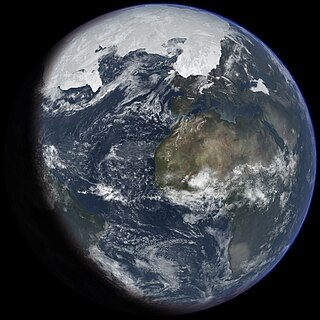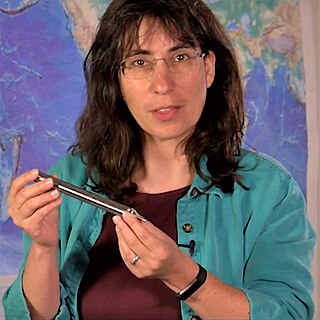Related Research Articles

An ice age is a long period of reduction in the temperature of Earth's surface and atmosphere, resulting in the presence or expansion of continental and polar ice sheets and alpine glaciers. Earth's climate alternates between ice ages and greenhouse periods, during which there are no glaciers on the planet. Earth is currently in the Quaternary glaciation. Individual pulses of cold climate within an ice age are termed glacial periods, and intermittent warm periods within an ice age are called interglacials or interstadials.

A raised beach, coastal terrace, or perched coastline is a relatively flat, horizontal or gently inclined surface of marine origin, mostly an old abrasion platform which has been lifted out of the sphere of wave activity. Thus, it lies above or under the current sea level, depending on the time of its formation. It is bounded by a steeper ascending slope on the landward side and a steeper descending slope on the seaward side. Due to its generally flat shape, it is often used for anthropogenic structures such as settlements and infrastructure.

Post-glacial rebound is the rise of land masses after the removal of the huge weight of ice sheets during the last glacial period, which had caused isostatic depression. Post-glacial rebound and isostatic depression are phases of glacial isostasy, the deformation of the Earth's crust in response to changes in ice mass distribution. The direct raising effects of post-glacial rebound are readily apparent in parts of Northern Eurasia, Northern America, Patagonia, and Antarctica. However, through the processes of ocean siphoning and continental levering, the effects of post-glacial rebound on sea level are felt globally far from the locations of current and former ice sheets.

The Eemian was the interglacial period which began about 130,000 years ago at the end of the Penultimate Glacial Period and ended about 115,000 years ago at the beginning of the Last Glacial Period. It corresponds to Marine Isotope Stage 5e. Although sometimes referred to as the "last interglacial", it was the second-to-latest interglacial period of the current Ice Age, the most recent being the Holocene which extends to the present day. The prevailing Eemian climate was, on average, around 1 to 2 degrees Celsius warmer than that of the Holocene. During the Eemian, the proportion of CO2 in the atmosphere was about 280 parts per million.

The Last Glacial Maximum (LGM), also referred to as the Late Glacial Maximum, was the most recent time during the Last Glacial Period that ice sheets were at their greatest extent. Ice sheets covered much of Northern North America, Northern Europe, and Asia and profoundly affected Earth's climate by causing drought, desertification, and a large drop in sea levels. Based on changes in position of ice sheet margins dated via terrestrial cosmogenic nuclides and radiocarbon dating, growth of ice sheets commenced 33,000 years ago and maximum coverage was between 26,500 years and 19–20,000 years ago, when deglaciation commenced in the Northern Hemisphere, causing an abrupt rise in sea level. Decline of the West Antarctica ice sheet occurred between 14,000 and 15,000 years ago, consistent with evidence for another abrupt rise in the sea level about 14,500 years ago. Glacier fluctuations around the Strait of Magellan suggest the peak in glacial surface area was constrained to between 25,200 and 23,100 years ago. Continental ice sheets never reached their isostatic equilibrium during the LGM, as evidenced by high variability in ice volume over short spans of time.
Christopher Thomas Russell is head of the Space Physics Center at the Institute of Geophysics and Planetary Physics (IGPP) at UCLA, professor in UCLA's Department of Earth, Planetary, and Space Sciences, and Director of the UCLA Branch of the California Space Grant Consortium. He received a B.Sc. from the University of Toronto in 1964 and a Ph.D. from UCLA in 1968. In 1977 he was awarded the James B. Macelwane Medal and in 2003 the John Adam Fleming Medal by the American Geophysical Union (AGU). He is also a Fellow of the AGU. Asteroid 21459 Chrisrussell was named after him in 2008. In 2017, he was awarded the NASA Distinguished Public Service Medal. He has three grandchildren.

The Quaternary glaciation, also known as the Pleistocene glaciation, is an alternating series of glacial and interglacial periods during the Quaternary period that began 2.58 Ma and is ongoing. Although geologists describe this entire period up to the present as an "ice age", in popular culture this term usually refers to the most recent glacial period, or to the Pleistocene epoch in general. Since Earth still has polar ice sheets, geologists consider the Quaternary glaciation to be ongoing, though currently in an interglacial period.

Glacier morphology, or the form a glacier takes, is influenced by temperature, precipitation, topography, and other factors. The goal of glacial morphology is to gain a better understanding of glaciated landscapes and the way they are shaped. Types of glaciers can range from massive ice sheets, such as the Greenland ice sheet, to small cirque glaciers found perched on mountain tops. Glaciers can be grouped into two main categories:
The geology of Illinois includes extensive deposits of marine sedimentary rocks from the Palaeozoic, as well as relatively minor contributions from the Mesozoic and Cenozoic. Ice age glaciation left a wealth of glacial topographic features throughout the state.

Roger David Kornberg is an American biochemist and professor of structural biology at Stanford University School of Medicine. Kornberg was awarded the Nobel Prize in Chemistry in 2006 for his studies of the process by which genetic information from DNA is copied to RNA, "the molecular basis of eukaryotic transcription."
Throughout Earth's climate history (Paleoclimate) its climate has fluctuated between two primary states: greenhouse and icehouse Earth. Both climate states last for millions of years and should not be confused with glacial and interglacial periods, which occur as alternate phases within an icehouse period and tend to last less than 1 million years. There are five known Icehouse periods in Earth's climate history, which are known as the Huronian, Cryogenian, Andean-Saharan, Late Paleozoic, and Late Cenozoic glaciations. The main factors involved in changes of the paleoclimate are believed to be the concentration of atmospheric carbon dioxide, changes in Earth's orbit, long-term changes in the solar constant, and oceanic and orogenic changes from tectonic plate dynamics. Greenhouse and icehouse periods have played key roles in the evolution of life on Earth by directly and indirectly forcing biotic adaptation and turnover at various spatial scales across time.
David A. Hodell is a geologist and paleoclimatologist. He currently holds the position of Woodwardian Professor of Geology in the Department of Earth Sciences at the University of Cambridge, where he is also a fellow of Clare College. He is a dual citizen of the United Kingdom and the United States. Previously, he taught at the University of Florida from 1986–2008, earning the rank of full professor in geological sciences. Hodell was also the director of the Stable Isotope Laboratory from 1996–2008. Hodell earned his Ph.D. in 1986 in oceanography from the University of Rhode Island after earning his bachelor of arts in 1980 in geology from the University of Vermont.
Terence Vincent Callaghan is a British biologist specialized in the ecology of the Arctic. Much of his work on arctic plants has taken place in Abisko in northernmost Sweden, based at the Abisko Scientific Research Station where he served as director. He was a lead author of the IPCC Fourth Assessment Reports chapter on polar regions.

Emily E. Brodsky is a Professor of Earth Sciences at the University of California, Santa Cruz. She studies the fundamental physical properties of earthquakes, as well as the seismology of volcanoes and landslides.
Marin Kristen Clark is an American earth scientist who is Chair for Earth and Environmental Sciences at the University of Michigan. Her research considers lithospheric deformation. She was awarded the 2003 Geological Society of America Doris M. Curtis Award.
Bette Otto-Bliesner is an earth scientist known for her modeling of Earth's past climate and its changes over different geological eras.
Jean Lynch-Stieglitz is a paleoceanographer known for her research on reconstructing changes in ocean circulation over the last 100,000 years.
Laura Frances Robinson is a British scientist who is Professor of Geochemistry at the University of Bristol. She makes use of geochemistry to study the processes that govern the climate. In particular, Robinson studies radioactive elements, as these can be analysed in geological materials. She was awarded the 2010 President's Award of the Geological Society of London.
James P. Kennett is an American paleoceanographer. In 1986, Kennett became the founding editor of Paleoceanography, and in May 2000, he was elected as a member of the National Academy of Sciences. He is also a cofounder and member of the Comet Research Group.
Elisabeth Lynn Sikes is an American geoscientist who is a professor at Rutgers University. Her research considers carbon cycling. She was awarded the 2022 Scientific Committee on Antarctic Research Medal for Excellence in Research.
References
- ↑ "Jerry X. Mitrovica; Frank B. Baird, Jr. Professor of Science". eps.harvard.edu. Harvard University . Retrieved February 3, 2021.
- ↑ "Kirk Bryan Award". community.geosociety.org. Geological Society of America . Retrieved February 3, 2021.
- ↑ "Harvard's Mitrovica awarded MacArthur 'genius grant'". news.harvard.edu. 25 September 2019. Retrieved February 3, 2021.
- ↑ http://www.nasonline.org/programs/awards/arthur-l-day-prize.html